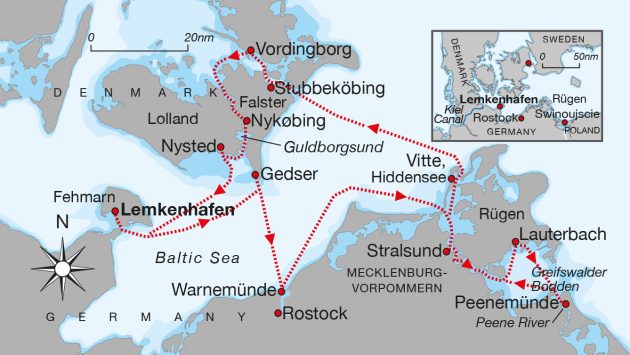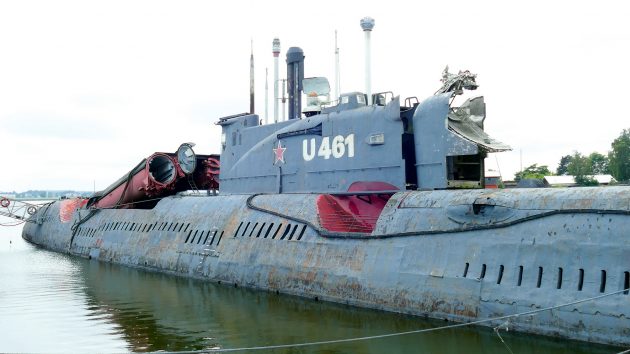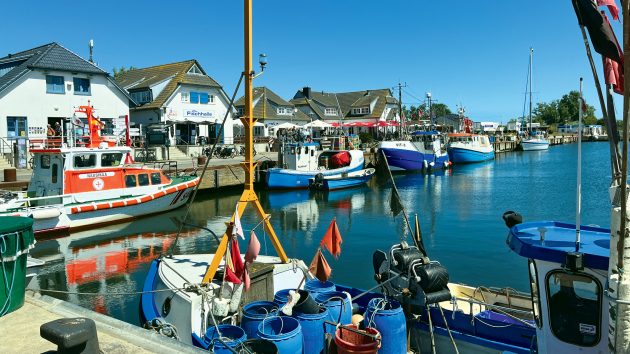The coast of former East Germany offers Karen Eriksen and family tranquility and history in equal measure
Shortly after the Berlin Wall came down in 1989, I moved abroad from Germany. On the occasions I did return I rarely ventured further than Hamburg where my family lived. Yet now, here we were, sailing to a completely unknown country – the former East Germany.
Our family, now based in Sydney, planned an exploratory cruise along the coast of Mecklenburg-Vorpommern – a state in the north-east of Germany. The Baltic is renowned as a soft cruising ground without tide or major swells and is perfect for sailing between the months of June and August. Every few miles there is a marina with all the facilities to welcome sailors at a reasonable cost. Navigation in these more southern reaches of the Baltic is also quite easy.
Exploring unknown territory
Looking at the innocent sandy coast, I felt deeply for the many Germans who had been living in a communist state next door. More than 40 years ago, I had raced in a dinghy regatta nearby and recall trying to pinpoint the invisible East-West marine border. Our biggest fear then was to be swept across the Iron Curtain, arrested by hostile patrol boats, never to return home. More than 5,600 East Germans tried to flee the GDR across the Baltic from 1961 to 1989. They used surfboards, kayaks and lilos, but only around 1,000 people made it and many died.
I was joined on the cruise by my husband, John, and my teenage daughter, Lizzie. We set sail from Lemkenhafen on the island of Fehmarn where our classic Hornet 32 Dania had been stored during the pandemic years.

Husband, John, and teenage daughter, Lizzie, enjoy a cool beverage
A sail through the shallow Mecklenburg fairways would lead us to the natural beauty of the Bodden waters – small lagoons, many of them protected. Further on through the Stettiner Haff (also known as the Szczecin Lagoon) we would hopefully reach the Polish port city of Swinoujście and the surrounding area, which is steeped in ancient and modern history and said to be a stunning cruising ground.
Our first East German harbour after a long, eventless motor-sail, was the seaside resort of Warnemünde, near Rostock. Along the old harbour, tourists filled the busy shops and restaurants and frequented the food stalls there selling the tasty local smoked fish. The former fishing village dates from the 1200s and is touristy, but still charming.
It was hot, very hot. John couldn’t resist the long white beach alongside thousands of other holidaymakers and took a dip in the Baltic Sea despite its cool 17º waters. Further along, the beach was overshadowed by the massive concrete block of the Hotel Neptun, 64m high and completed in 1971. In GDR times the majority of its rooms were allocated to employees of state companies, selected by ‘socialist criteria’ who could stay for around 12 nights, paying very little. The hotel also hosted international guests of the GDR such as Cuban leader Fidel Castro and West German Chancellor Willy Brandt.

The seaside resort of Warnemünde
A passing storm
We found that a shallow draught was really helpful in the narrow marked channels found here. The next afternoon, we were broad reaching at a good speed toward the historic town of Stralsund in a very narrow, but marked, channel while the dark blue sky looked increasingly threatening.
Thunderstorms in northern Europe can trigger big, unexpected gusts of wind. As soon as we had some room, we lowered both sails, and just in time. A sheet of rain led to zero visibility, and
we motored on the spot, checking our position on a navigation phone app. Within 10 minutes the front had passed and Unesco-listed Stralsund lay ahead of us.
We had trouble finding a spot in the crowded marina, but a nice lady in a swimsuit and towel beckoned us into a corner to a free berth. The red/green sign system was new to the skipper and initially we were reluctant to motor far into a berth corridor. All the marinas in this area are well equipped with shower blocks and often laundry facilities. Stralsund, with its historic buildings, huge aquarium, pedestrian zone and former sail training ship Gorch Fock, had so much to offer and we stayed for several days.
We spotted a Trabant, one of the two-stroke cars formerly prevalent in East Germany. The car became symbolic of the former East Germany’s stagnant economy and the subsequent collapse of the Eastern Bloc. Formerly, Eastern residents waited patiently for years to obtain the Trabant after ordering, while in West Germany people were already driving Mercedes cars.

It was a maiden voyage for the family’s classic Hornet 32, Dania
There was a lot of bitterness and envy in the East after the Berlin Wall came down in 1989 and there was also resentment in the West against the Ossis (East Germans) for their perceived ungratefulness, as a united Germany became a reality.
The next day we waited in a crowd of boats for the Stralsund lifting bridge to open. For a good hour, just under genoa, Dania meandered through the shallow fairway towards one of the Bodden waters south of the island of Rügen, a wide inland expanse of water.
We saw a sea eagle, plenty of water birds and an ancient navy boat along the shore. The Bodden waters have many harbours and picturesque villages to explore.

In Lauterbach, on the northern side of the Greifswalder Bodden, we never made it into town but settled into a harbourside café, enjoying a cocktail or two and dancing along to the dulcet tones of a local singer who entertained the elderly holiday makers.
A fast beam reach in 18 knots of breeze across the Bodden made up for the sudden grey sky and cold the next day, and our solid little Hornet was in her element, eating up the miles. Soon we entered the Peene river, marked by big concrete sea marks. John and I were thrilled to be able to visit Peenemünde.
From 1936 to 1945, the Nazi research stations in Peenemünde formed the largest armaments centre in Europe. The centre stretched over 25 square kilometres and up to 12,000 people worked on guided weapons, most famously the world’s first cruise missiles and the first ever functioning large-scale rockets, V1 and V2.
We had just read V2, the novel by Robert Harris, which is about the Nazi rocket-building programme, so we were keen to visit the museum of the birthplace of modern rocket science and the vast power plant next door.

After securing a berth in the marina, bow to the jetty, as is common, we first took a look at the Soviet submarine U461 on the dock. We had taken the kids to see many submarines in museums worldwide, and Lizzie agreed that we had never seen anything as messy as this one, with its chaotic pipes and convoluted machinery.
The rocket museum was overwhelming in its size, detail and displays – both interesting and shocking. We could easily have spent more time here. We took a lift to a viewing platform on top of the power plant from which the displayed rocket looked tiny.
Back at the boat, we listened to the long-range weather forecast. Bad news! It seemed a trip to Poland wasn’t meant to be on this cruise. A lasting front system with strong westerlies would arrive soon and put a stop to our plans to venture further east.
The Baltic doesn’t have an ocean swell but there is a choppy, nasty sea when it is windy. As so often in sailing, nature dictates the course, and we turned around towards the gem of these cruising grounds, the island of Hiddensee and the idyllic harbour of Vitte.

From 1936-1945, the research site at Peenemünde was the largest armaments centre in Europe
Island escape
Another very narrow, shallow channel made sailing impossible and we motored there. In a far corner we found a berth, and, thanks to our draught of 1.4m, we went straight in.
The long, thin, 19-km-square island of Hiddensee was a retreat for artists and writers during the 20th century. Nobel literature prize laureate, Thomas Mann, had a holiday house here that he visited often with his large family in the 1920s.

he family enjoy a hearty meal aboard. Son Finn is at university in Australia
The island is as popular as ever but cars are not allowed, and Hiddensee is fortunately too small for an airport. This gives it a tranquil feeling with an atmosphere from a bygone time. A little ferry connects to Rügen and horse carts drive tourists to their accommodation.
It was time to head back. The wind was up, we donned our oilskins and left East Germany behind. Close-hauled in the brisk westerly, we made it to Stubbeköbing in Denmark, a harbour my parents had liked, conquering the very shallow and narrow stretch of water Guldborgsund.
We enjoyed Danish ‘soft ice’ and hot dogs, took a train trip to Copenhagen and played mini golf in Nysted.
Once back home, we reflected. Our venture into the former German East had been a fascinating trip for me and my Australian family. We had loved the beautiful cruising grounds but particularly valued the insight into earlier, more difficult, times.
Enjoyed reading this?
A subscription to Yachting Monthly magazine costs around 40% less than the cover price.
Print and digital editions are available through Magazines Direct – where you can also find the latest deals.
YM is packed with information to help you get the most from your time on the water.
-
-
- Take your seamanship to the next level with tips, advice and skills from our experts
- Impartial in-depth reviews of the latest yachts and equipment
- Cruising guides to help you reach those dream destinations
-
Follow us on Facebook, Twitter and Instagram.





